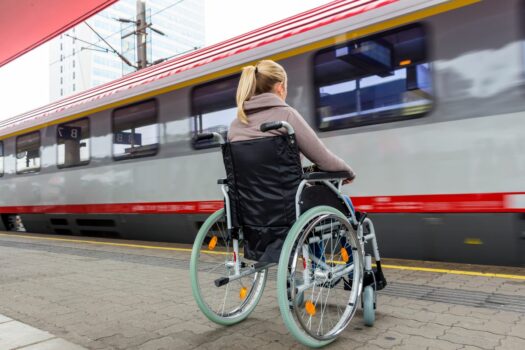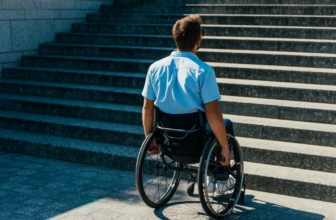These tips can help you use public transit alone as a traveler with a physical disability, even in a new and unfamiliar city.
Public transit can be an efficient, affordable way to get around. But, as someone who uses a walker due to having cerebral palsy, I’ve learned that it takes some extra effort to be a physically disabled public transit user. Things can also be a bit more challenging because I usually travel alone — often due to circumstances rather than preference.
That said, I love exploring new places and usually rely on public transit to help. It has taken many years for me to build up the confidence to do it, but I hope by sharing some of my tips here, I can help you feel more empowered, too.
Learn the Process for Requesting Assistance with Public Transit
I’ve used public transit in the United States and Europe, and all operators I’ve dealt with have had processes for requesting assistance. Usually, that means sending an email or calling a phone number within a specific time period before the intended departure date. Some transit companies have apps you can use to book assistance. Occasionally, I can just show up on the day of travel and tell a staff member what kind of help I require.
However, I highly recommend going directly to the transit operator’s website and getting the details well in advance. Look for sections of the site such as “accessibility” or “traveling with a disability” to get the information needed. If applicable, be sure to capture screenshots or bring printed documents that show you have requested help through the proper channels.
Remain as Flexible as Possible
Although things are getting better for physically disabled travelers, there’s still a long way to go. For example, only 27% of the subway stations in New York City’s subway system meet the Americans With Disabilities Act’s accessibility requirements. There’s a 30-year timeline to reach a 95% accessibility goal. I love New York City, but the subpar accessibility at some stations has meant I’ve sometimes needed to get off at a station other than the one I wanted to make sure there was a working elevator available to use.
In several cases, I’ve been preparing to book train tickets and noticed alerts on a transit station’s website about elevators being out of service — sometimes for months at a time. These instances are undoubtedly stressful and disappointing.
However, rather than letting them hold you back and automatically assuming you must cancel your plans, speak to a station operator by phone and explain your situation. See if there’s anything they can recommend, such as traveling on a different date or changing your departure or arrival stations.
Alternatively, if you’ve already booked tickets and encounter a problem, be assertive about asking for a refund. Staying as flexible as you can should help you make the most of unfortunate situations.
Familiarize Yourself With Transit Timing Specifics
I have to be very aware of my physical limitations when using public transit. I often see fellow passengers running to catch their trains, pulling their luggage behind them. However, that’s not an option for me, and even trying to hurry makes me anxious and more likely to fall. That’s why I give myself plenty of time whenever possible, even if that means taking an earlier train or bus than I need.
Pay close attention to how much time you’ll have to make connecting trains and buses, if applicable. Think about how long it usually takes you to move from point A to point B, and add some extra time since you’ll be moving through unfamiliar surroundings.
Consider how much traveling at peak periods could impact your plans, too. Many routes listed on Google Maps in certain cities have details about how crowded the trains and buses are at specific times. I’ve occasionally needed to wait for a less crowded bus or train.
However, one advantage to having an assistance request booked through the transit system is that the employees helping you should do whatever they can to ensure you get on the intended route.
If you’ve booked assistance through a transit operator’s system and miss one of your connections, make sure to inform an employee. On a recent occasion, while traveling through an unfamiliar part of the United Kingdom by train, an unspecified emergency caused us to stop at a station for about a half-hour. I knew that’d make me miss my connecting train.
As soon as I got on the next train, I explained to the first employee I saw that I’d be arriving later than expected to my destination because of a situation out of my control. She said she was glad I’d mentioned that because her colleagues were unaware of the previously delayed train. Never assume that anyone assisting with your accessibility needs will know about things that have gone wrong along the way. Consider yourself the only one who will advocate for what you need.
Assert Your Needs When Using Public Transit with a Disability
My experience using public transit as a solo traveler for decades has been that I can’t always count on the assistance I’ve booked to be there as requested. Even if you know how to ask for help and have done it correctly in advance, I strongly recommend speaking to someone at the transit station on the day of travel to confirm.
Tell them you have booked assistance and want to make absolutely sure that someone knows your travel route and will be there at each of your stops. Doing this is critical when I travel by train because I need an employee to bring a ramp to the platform so I can get on and off.
However, I communicate with bus drivers, too. Saying something such as, “I’m getting off at the West Street stop and will need you to get my mobility aid out from under the bus when we arrive” suffices in my case.
Telling Strangers How to Help
Being assertive also extends to instructing people who offer to help when they see you might need it. There have been several instances where people have noticed me waiting for an employee to bring the ramp to get off the train, and then asked if they could do anything. My walker has a poor design, and someone could easily break it if they lift it the wrong way.
I’ve been fortunate that people are almost always willing to help when the official assistance doesn’t show up. If you choose to accept strangers’ offers, I recommend instructing them with a sentence or two. I usually say something such as, “Yes, please lift my walker by holding it here, and set it on the train station platform. I can get off the train myself if you do that.”
Well-meaning strangers almost always try to grab onto me when offering help. However, that can put me off balance. That’s the main reason why I’ve found it best to be as clear and concise as possible when explaining how people can help me — and what they shouldn’t do.
Setting Expectations With Friends
Even if you mostly travel alone, you might meet people at the destination and explore more places with them. Alternatively, friends may decide at the last minute they want to come along, or you might invite them.
In any of these situations, be straightforward about how any limitations might affect your plans — especially if these friends are non-disabled or less familiar with how your disabilities impact you.
I’ve had many cases where someone I’m with has said something such as “Google Maps says it’s only a 10-minute walk to the bus station, so there’s no need to leave so early.”
But, in that example, I know it takes me longer to reach places than maps apps say, and that’s especially true if I don’t know the area. Saying something such as, “I don’t walk very fast and would prefer we leave now so we’re not rushed” usually does the trick.
Practice Carrying Your Luggage
Depending on the length of your public transit journey, you might have some luggage to handle on the trip. This situation comes up for me quite often because I enjoy camping, and often get to the sites via public transit.
You may find bringing luggage along introduces some new challenges. The walker I primarily use for traveling has a big basket in the front. It’s helpful for the most part, but all the extra weight caused by putting luggage there makes it harder to lift my mobility aid onto a bus or curb.
Consider spending time figuring out which bags you’ll bring and how you’ll carry them. Then, practice doing it in a familiar environment, such as your home. Notice if the luggage affects how you move or use a mobility aid, then think of what you could do to make things as easy as possible.
You may also want to keep the items used most frequently — such as your wallet and phone — in a wearable pouch. I have a waterproof one worn around the neck that I put under my shirt to make it less conspicuous. That way, you’ll have the stuff easily accessible and won’t need to rummage through your luggage to find it.
Focus on What Went Well, and Be Kind to Yourself
I wish I could say most of my travels go smoothly. But, it’s more realistic to say that I’ve learned to be prepared for anything. Traveling on public transit means I must rely on others to help me get where I need to go, and I think that’s typically why things are more likely to go unexpectedly.
Planning is crucial because it gives you more options. For example, if the train or bus you plan to take is late or an employee never shows up to help you board, what can you do to get things back on track? It might mean getting to your destination later than anticipated, but you’ll almost always feel better when familiarizing yourself with the options in advance.
I tend to fixate on the things that didn’t go as I’d hoped. However, I’m trying to improve by reminding myself of all the positive aspects of my public transit trip. Did this mode of traveling enable me to enjoy a new experience or visit someone I love? Did I encounter some kind, friendly strangers on the route? Having a more balanced perspective makes me more eager to prepare for future trips.
You may find there were some things you miscalculated. Perhaps it was harder to carry your luggage than you thought, or you didn’t give yourself enough time to get to the bus station. Even if that’s the case, try not to get upset with yourself.
Traveling independently on public transit takes boldness and courage, so you’ve already done well by attempting it. Treat all perceived difficulties as opportunities to learn. What could you do differently next time? Take pride in everything you did to help things go well, too.
Viewing traveling as a continuous learning experience is a great way to figure out what works for you. The more comfortable you feel when exploring new places, the more likely you’ll be to feel excited about upcoming journeys.
If you're neurodivergent, check out our tips for train travel as an autistic person and coping with sensory issues on public transit.
I have 15 years of professional writing experience and am excited to use my voice through writing to help, educate, challenge and encourage others. I'm happiest when supporting the local arts scene, spending time in nature and engaging in activism and community development.







